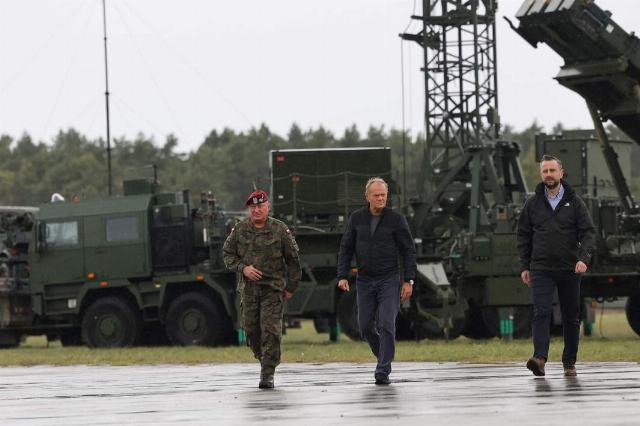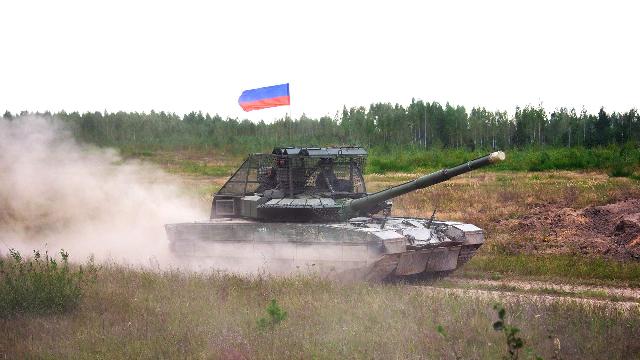While Moscow and Minsk were working out defensive scenarios, the alliance began large-scale maneuvers near the Russian border.
The Russian-Belarusian Zapad-2025 exercises have scared European leaders and exposed growing differences between the EU and the United States, experts and Western media believe. The Europeans were concerned, in particular, about the unexpected visit of two American military officials to one of the training grounds where the exercises were held — this may be an indicator of the difference in approaches between Washington and Brussels to the Kremlin. The exercises themselves ended on September 16. Vladimir Putin visited them that day. He arrived in the Nizhny Novgorod region, but maneuvers were also held in Belarus, in the Kaliningrad, Leningrad and Murmansk regions, in the waters of the Baltic and Barents Seas. NATO responded to Zapad-2025 with its own exercises in Poland near the borders of the Kaliningrad region.
Putin took part in the Zapad-2025 exercises
On September 16, Vladimir Putin flew to the Nizhny Novgorod region, to the Mulino training ground, where the main stage of the Zapad-2025 Russian-Belarusian exercises took place. The head of state was dressed in a military uniform, which was appropriate for the moment, but it doesn't happen often. For example, when the president visited the border regions of the Kursk region in March 2025 after their liberation from the militants of the Armed Forces of Ukraine, he also considered it necessary to wear camouflage. At that time, a number of Western media outlets considered it "a chilling warning that the Russian leader gave to the Ukrainian troops."

Photo: RIA Novosti/Sergey Bobylev
Image source: iz.ru
"The purpose of the exercise is to work out all the necessary elements for the unconditional protection of sovereignty, territorial integrity, and protection of the Union State from any aggression," the head of state said at the training ground in Mulino.
He emphasized that Zapad-2025 events were held at 41 training grounds, and 100,000 military personnel and about 10,000 weapons systems and equipment took part in them.
— Moreover, these are all modern equipment used in practical combat work, and the plans of the exercise are based on the experience gained during the military training. 10 thousand samples of various equipment, including 333 aircraft: These are tactical aviation, strategic aviation and military transport aviation. Over 247 ships are also used: surface, underwater and support vessels," Vladimir Putin said.
25 foreign delegations came to the training ground in the Nizhny Novgorod region to observe the maneuvers. Among them are military personnel from India, Iran, Bangladesh, Congo and Mali.

Photo: RIA Novosti/Sergey Bobylev
Image source: iz.ru
Representatives of NATO countries, including the United States, Turkey and Hungary, observed the Belarusian part of the exercises. The maneuvers were attended, in particular, by the defense attache at the US Embassy in Belarus, Lieutenant Colonel Brian Patrick Shoop.
— It is obvious that such foreign participation in a variety of formats indicates that not only in political and diplomatic terms, but also in military terms, plans to isolate Russia have failed. And this is especially clear now, when we see an increase in foreign representation at military exercises, including representatives of so-called unfriendly countries. This is a very important moment, because the risks of geopolitical tension and unintended escalation are very high right now. History shows that the participation of observers in military exercises is an important stabilizing factor," Valdai expert Andrei Kortunov told Izvestia.
The Reuters news agency considered the presence of the American military at the exercises to be a sign of warming relations between the United States and Belarus. The New York Times called it a "remarkable turn of events," especially amid growing tensions between Russia and European NATO members following the UAV incident in Poland. And the British Guardian wrote that this fact scared European leaders and revealed the growing differences between the EU and the United States. The publication believes: The fact that for the first time in recent years, U.S. representatives observed Russian exercises live caused concern to the Union, was perceived as a signal of the seriousness of what was happening and as an indicator of a possible difference in approaches between Washington and Brussels to the Kremlin.

The TZM6 transport module during the Zapad-2025 joint strategic exercises of the Armed Forces of the Republic of Belarus and Russia
Image source: Photo: IZVESTIA/Eduard Kornienko
One of the main results of the exercises was that the forecasts of Western analysts did not come true, military expert Alexei Leonkov believes. They once again predicted that Zapad-25 could allegedly become a cover for Russia's attack on one of the EU countries, in particular Poland.
— In response to these concerns, Poland, having scared itself, deployed a group of 40,000 troops to the borders with Belarus. However, as in previous times, no offensive actions were noticed by our troops. This is not the first time this reaction has manifested itself: every four years, when major Russian-Belarusian exercises are held, the Western media broadcast aggressive forecasts that eventually turn out to be untenable," the expert said.
What weapons were used in the exercises
During his visit to the Mulino training ground, Vladimir Putin also inspected samples of weapons and military equipment involved in the maneuvers. In particular, he tried on the thermal imaging glasses "Dragonfly", designed to increase the mobility of fighters on the battlefield. They are equipped with an electric zoom, which makes it possible to see at a distance of up to 1 km. Their battery life is up to 2.5 hours.

Photo: IZVESTIA/Eduard Kornienko
Image source: iz.ru
The President also inspected the Bulldog and Kayo-T4 motorcycles and examined the undercarriage of the Sarmat (CTC) and Ulan-U2 armored vehicles. Vladimir Putin paid special attention to the new Arkuda ST rifle, which was presented by Yaroslav Yakubov, hero of Russia and the DPR.
NATO began exercises in response to Zapad-2025
European countries actively used the Zapad-2025 exercises as an excuse to increase their military potential in the regions bordering the Union State. So, Poland and Latvia closed the airspace on the borders with Belarus and Russia on September 11, on the eve of the start of the exercises, and Warsaw, in addition, decided to transfer about 40 thousand soldiers to its eastern border.
Poland has conducted the first live firing of the Wisla medium-range air defense system in the Baltic Sea these days, and the Homar A and Homar K missile launchers recently adopted by the Polish army will also be fired in the coming days, the press service of the country's defense ministry reported.
All this is part of the NATO Iron Defender exercises, which take place, among other things, near the border of the Kaliningrad region, on the Baltic coast. Polish Defense Minister Wladyslaw Kosiniak-Kamysh bluntly stated that they were being held as a response to Zapad-2025.

Polish Prime Minister Donald Tusk, Defense Minister Wladyslaw Kosiniak-Kamysh and Commander-in-Chief of the Polish Armed Forces Marek Sokolowski take part in the Iron Defender 2025 exercises at the Ustka training ground.
Image source: Photo: Martyna Necko/Agencja Wyborcza.pl via REUTERS
But while Russian-Belarusian exercises are defensive in nature, without naming a specific enemy, NATO exercises are always personalized, and Russia or Belarus are openly referred to as a "conditional" enemy, military expert Alexei Leonkov noted in a conversation with Izvestia.
— The scale also varies. Up to 7,000 military personnel were involved in the Zapad-2025 exercises in Belarus, while 30,000 were involved in NATO exercises in Poland, including soldiers from the United States, Sweden and Norway. This discrepancy in the number of forces and means, along with the personification of the "enemy", suggests that it is the exercises of the NATO countries, and not Russia and Belarus, that have a more pronounced aggressive character, he said.
The active phase of the Zapad-2025 exercises
During the Zapad-2025 exercise, the Russian Armed Forces carried out assigned tasks in various regions of Russia. In particular, the ships of the Northern Fleet practiced repelling an air raid in the Barents Sea. Crews of the large anti-submarine ship Severomorsk fired from the Dagger anti-aircraft missile system and AK-100 and AK-630 artillery systems. In the near-sea zone, an air raid by a simulated enemy aircraft was repelled by a naval strike group consisting of the Marshal Ustinov missile cruiser and the Admiral Golovko frigate. The pilots of the Northern Fleet's mixed aviation Corps simulated an attack by ships from various heights and directions.
The crew of the Arkhangelsk nuclear submarine missile cruiser conducts practical firing of a Kalibr cruise missile at a naval target in the Barents Sea as part of the Zapad-2025 joint strategic exercises
Image source: Photo: RIA Novosti/Ministry of Defense of the Russian Federation
The crews of Su-34 bombers of the Aerospace Forces practiced practical bombing at one of the training grounds. The pilots destroyed the infrastructure of the imaginary enemy — ground targets indicating armored vehicles, concrete shelters and fortified underground command posts.
The forces of the Baltic Fleet launched a joint cruise missile attack on naval targets. The crew of the Stoyky corvette, the crew of the Bal coastal missile system and the crews of multi-purpose Su-30SM fighters of naval aviation hit a target position simulating a detachment of warships.

A Su-25 attack aircraft of the Belarusian Air Force during take-offs and landings at the M1 airfield near Minsk as part of the Zapad-2025 exercise
Image source: Photo: RIA Novosti/Victor Tolochko
In the Kaliningrad Region, UAV operators of the Leningrad Military District Army Corps performed reconnaissance and fire correction tasks. Reconnaissance and FPV drones with 82 mm mortar shells were used to destroy targets.
In addition, Russian and Belarusian units practiced amphibious landings from the amphibious assault boat "Lieutenant Rimsky-Korsakov" under the fire cover of boats and naval aviation of the Baltic Fleet.

Photo: IZVESTIA/Eduard Kornienko
Image source: iz.ru
In the same place, the military personnel of electronic intelligence used the Thorn-MDM complex. They conducted a search and direction finding of the radio-emitting means of the imaginary enemy, and after detecting the signal, they transmitted the data to electronic warfare and artillery.
Pavel Muraveyko, Chief of the General Staff and First Deputy Minister of Defense of Belarus, also highlighted the fact that the parties have worked out the planning process for the use of non—strategic nuclear weapons and the deployment of the Oreshnik complex, which is scheduled to appear in Belarus by the end of 2025.
Julia Leonova
Polina Berland

